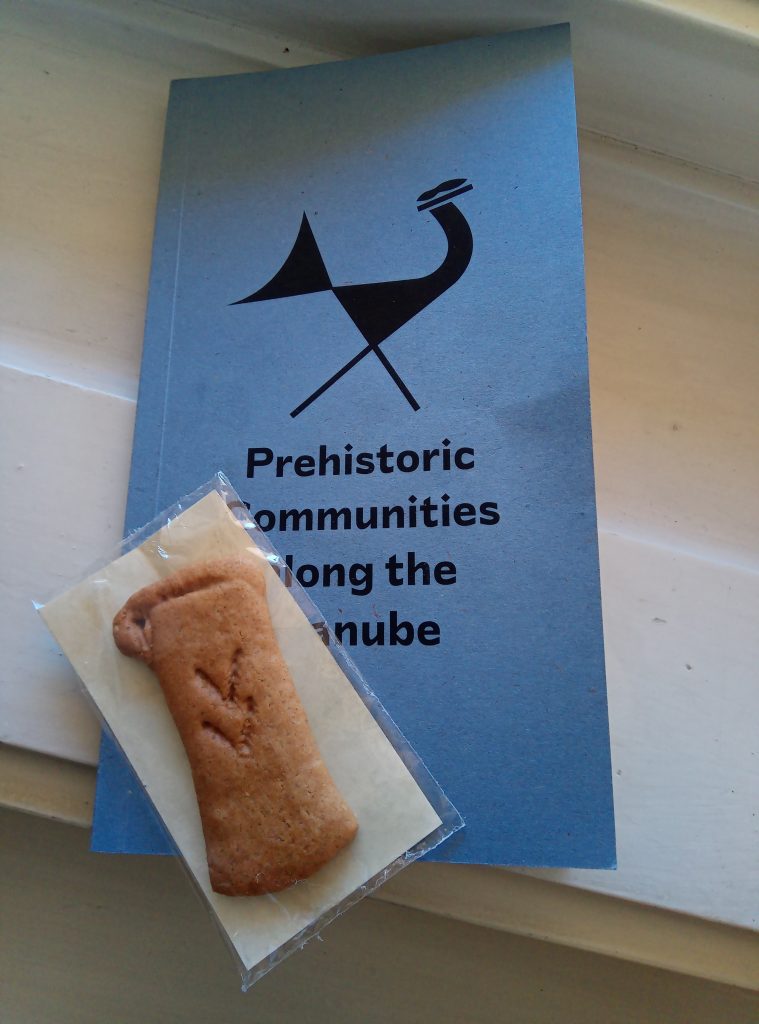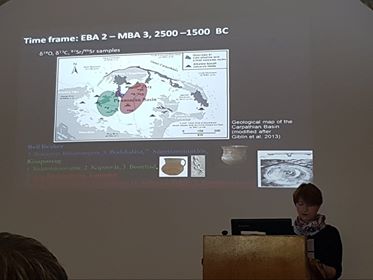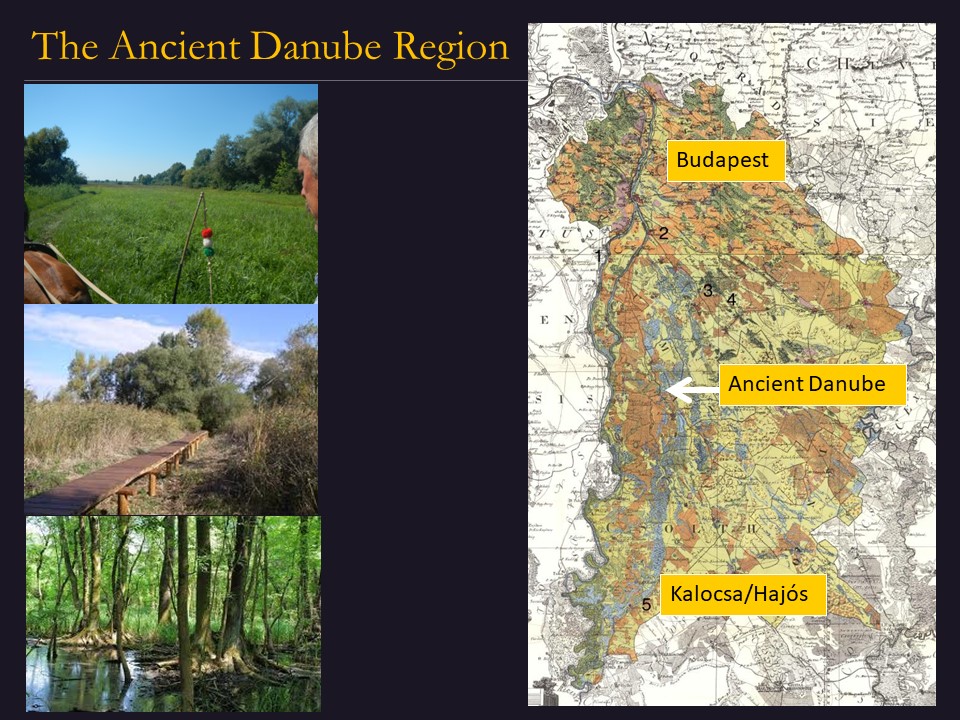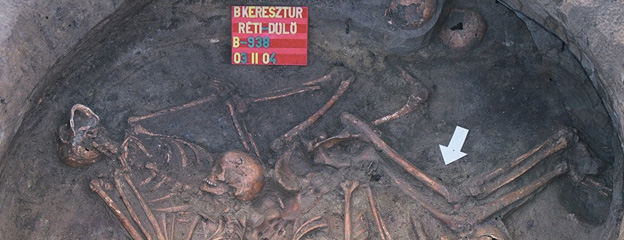Őskori közösségek a Duna mentén – nemzetközi konferencia Eszéken
November végén (28–29-én) Eszéken jártunk a Zágrábi Régészeti Intézet és az Eszéki Régészeti Múzeum szervezésében Prehistoric Communities along the Danube címmel megrendezett nemzetközi konferencián. A meghívott német, osztrák, szerb, magyar és horvát szakemberek a kétnapos tanácskozáson a térség újkőkorától a vaskorig tekintették át a legújabb kutatásokat, összefoglalva az eddigi eredményeket, és a jelenleg is nyitott kérdéseket, kijelölve a további elemzési irányokat.

A mézes sütiért Divna Gačić kollégát illeti köszönet
A konferencián kutatócsoportunk legfrissebb bioarcheológai és településhálózati kutatásainak eredményeit tekintettük át.
Kiss Viktória kutatócsoportvezető a Kr. e. 2500 és 1500 közé eső időszakból vizsgált temetkezések izotópos vizsgálata segítségével mutatta be a mai Magyarország keleti és nyugati részében jellemző bronzkori mobilitási mintázatokat. Egyes közösségek esetében a nem-helyben született egyének száma eléri a vizsgált egyének 40%-át: a bevándorlók között elsősorban nők, de férfiak és gyermekek is voltak. Eredményeink alapján a jelentős mértékű vándorlások nem pusztán a korszakban már megfigyelt exogám házasodási szokásokkal (Knipper et al. 2017; Mittnik et al. 2019), vagyis messze földről hozott asszonyokkal, hanem kisebb közösségek vándorlásával is összefüggésbe hozhatók bronzkor első ezer évében (Giblin et al. 2018).

Beszámoltunk a közép-magyarországi településkutatás legújabb eredményeiről is. Kulcsár Gabriella előadásában a térség kora és középső bronzkori településszerkezetéről eddig ismert adatok és friss kutatások kapcsán foglalta össze a hierarchikus településszerkezetre utaló modelltől (Kristiansen–Earle 2010) eltérő információkat. Az új adatok felvetik a kora és középső bronzkori társadalom felépítéséről való ismeretek újragondolásának szükségességét (Dani et al. 2019).

Hajdu Tamás „Kulturális hatás vagy vándorlás? Népesség- és életmódváltozások a Kárpát-medencében a Kr.e. 2. évezredben” (NFKI FK – 128013) projektjével együttműködésben a bronzkori mobilitás mintázatainak embertani szempontú adatait vizsgáltuk. A közel 600 eltemetett egyén koponya méreteinek statisztikai elemzésével a bronzkori kultúrák közötti lehetséges biológiai kapcsolatokra derítettünk fényt. Prezentációnk a Kárpát-medence északnyugati részére fókuszált. Az innen rendelkezésre álló antropológiai adatok a korábbi kutatással összhangban (K. Zoffmann–Hajdu 2017) arra utalnak, hogy a harang alakú edények népe és a zsinórdíszes kerámia kultúrájának leszármazottai meghatározó szerepet játszottak a régió és később a Kárpát-medence más régióinak népességeiben a Kr. e. 2200–1300 közötti időszakban.

Irodalom
Dani, J., P. Fischl, K., Kulcsár, G., Szeverényi, V., Kiss, V.: Dividing space, dividing society: fortified settlements in the Carpathian Basin (c. 2300–1500 BC). In: Meller, H.–Friedrich, S.–Küßner, M.–Stäuble, H.–Risch, R. (Hrsg.): Siedlungsarchäologie des Endneolithikums und der frühen Bronzezezeit – Late Neolithic and Early Bronze Age Settlement Archaeology. 11. Mitteldeutscher Archäologentag vom 18. bis 20. Oktober 2018 in Halle (Saale) – 11th Archaeological Conference of Central Germany October 18–20, 2018 in Halle (Saale). Tagungen des Landesmuseums für Vorgeschichte Halle 20, Halle (Saale) 2019, 851–868.
Knipper, C., Mittnik, A., Massy, K., Kociumaka, C., Kucukkalipci, I., Maus, M., Wittenborn, F., Mezt, S., Staskiewicz, A., Krause, J., Stockhammer, P.W.: Female exogamy and gene pool diversification at the transition from the Final Neolithic to the Early Bronze Age in central Europe. PNAS 114 (2017) 10083–10088
Mittnik, A., Massy, K., Knipper, C., Witterborn, F., Friedrich, R., Pfrengle, S., Burri, M., Carlichi-Witjes, N., Deeg, H., Furtwängler, A., Harbeck, M., von Heyking, K., Kociumaka, C., Kucukkalipci, I., Lindauer, S., Metz, S., Staskiewicz, A., Thiel, A., Wahl, J., Haak, W., Pernicka, E., Schiffels, S., Stockhammer, Ph. W., Krause, J.: Kinship-based social inequality in Bronze Age Europe. Science 366 (2019) 731-734. DOI: 10.1126/science.aax6219
Giblin, J., Ayala, D. Czene, A., Csányi, M. Dani, J., Endrődi, A., Fábián, Sz., Hajdu, T , Köhler, K. Kulcsár, G., Melis, E., Patay, R. Szabó, G., Szécsényi-Nagy, A., Szeverényi, V., Kiss, V.: Bronze Age Burials from the Carpathian Basin: New Isotope Results (poszter). SAA 84th Annual Meeting, Albuquerque, New Mexico, U.S., 2019. April 10–14. Program book. Albuquerque 2019, 100.
Earle, T., Kristiansen. K. (eds): Organizing Bronze Age Societies. The Mediterranean, Central Europe, and Scandinavia Compared. ,University Press 2010.
Zoffmann, Zs.–Hajdu, T.: A Survey of Bronze Age Populations in the Carpathian Basin Based on Classical Anthropological Methods. In: Kulcsár G., Szabó G., Kiss V., Váczi G. (eds): State of the Hungarian Bronze Age Research. Proceedings of the conference held between 17th and 18th of December 2014. Budapest 2017, 251–276.
Előadásaink összefoglalói
Recent data of mobility patterns from Hungary during the 3rd and 2nd Millennium BC
Viktória Kiss, Andás Czene, Marietta Csányi, János Dani, Anna Endrődi, Szilvia Fábián, Tamás Hajdu, Kitti Köhler, Gabriella Kulcsár, Eszter Melis, Róbert Patay, Géza Szabó, Vajk Szeverényi, Dante Ayala, and Julia Giblin
In this paper we present new isotopic results collected from Bronze Age cemeteries of western and eastern Hungary. Burial assemblages of the mentioned region can be connected to Bell Beaker, Kisapostag, Vatya, Füzesabony, Gáta-Wieselburg and Tumulus cultures; many of these were associated with newcomers in the Carpathian Basin during the first one thousand years of the Bronze Age (2500–1500/1400 BC). Multiple isotopes (Sr87/Sr86, δ18O, and δ13C) were analyzed from tooth apatite samples from inhumation burials (n=95). Results are compared to regional isotopic estimations for the central part of the Carpathian Basin based on archaeological fauna (n=53) of the mentioned regions, as well as previously published data of other archaeological periods.
Bronze Age Settlement and Society along the Danube in Central Hungary
Gabriella Kulcsár
The presence of fortified multi-layer/tell/tell-like settlements is an important characteristic of the late Early Bronze Age and Middle Bronze Age (according to Hungarian terminology, ca. 2300/2200-1500/1450 BC) of the Carpathian Basin.
The aim of this paper is to review the available evidence on these settlements in central Hungary, and to describe and give a preliminary analysis of Middle Bronze Age settlements and settlement patterns along the Danube and in the Danube-Tisza interfluve, especially in three smaller areas on the right and left bank of the Danube. We discuss previous views on the significance of Middle Bronze Age fortifications, attempt to deconstruct the preconceptions they had been built upon and put forward a few preliminary observations upon which further research can be based.
The study of Early and Middle Bronze Age tells and fortified settlements can provide invaluable information on social, economic and political developments in the period. Nevertheless, we have to emphasize that due to this focus on larger centres, research has become biased. Such settlement studies can be fruitful only if smaller, outlying villages, hamlets, farms and off-site locations with cultural remains are also investigated. The picture that emerges from this review is that of great variability in terms of settlement forms, locations and relationship between settlements. We have to differentiate between various types of sites in terms of fortification, position within local and regional settlement hierarchies, etc. Issues such as the differences between the thickness of the sequence of layers of the sites that had been occupied for the same time-span must also be taken into consideration, since they indicate different modes of habitation, house destruction and abandonment, and the accumulation of settlement debris.
We think that the study of Bronze Age settlement and society in Hungary has reached a point where it needs to open a new chapter in research. A more mature theoretical background and the launching of a series of carefully planned, systematic microregional projects will hopefully provide a host of new information and exciting interpretations that will shed new light on a crucial period and area in European prehistory. In this presentation, we review the latest results of the past 10 years in Central Hungary.
Population changes in the Northwestern part of the Carpathian Basin during the Early and Middle Bronze Age
Eszter Melis, Tamás Szeniczey, Kitti Köhler, Július Jakab, Tamás Hajdu
Numerous Bronze Age archaeological cultures were described in the Carpathina Basin. The archaeological interpretation concerning the relationship between these cultures, based almost exclusively on the continuity of the material culture. However, this does not reflect necessarily biological relations. To address this problem, bioarchaeological methods including physical anthropological analysis are essential. We present the results of our study concerning the population history in the north-western part of the Carpathian Basin (Austria, Hungary, Slovakia) during the Early and Middle Bronze Age. Biological distance, based on linear cranial measurements, was used as a proxy for reconstructing the patterns of genetic affinity between the analysed populations.








